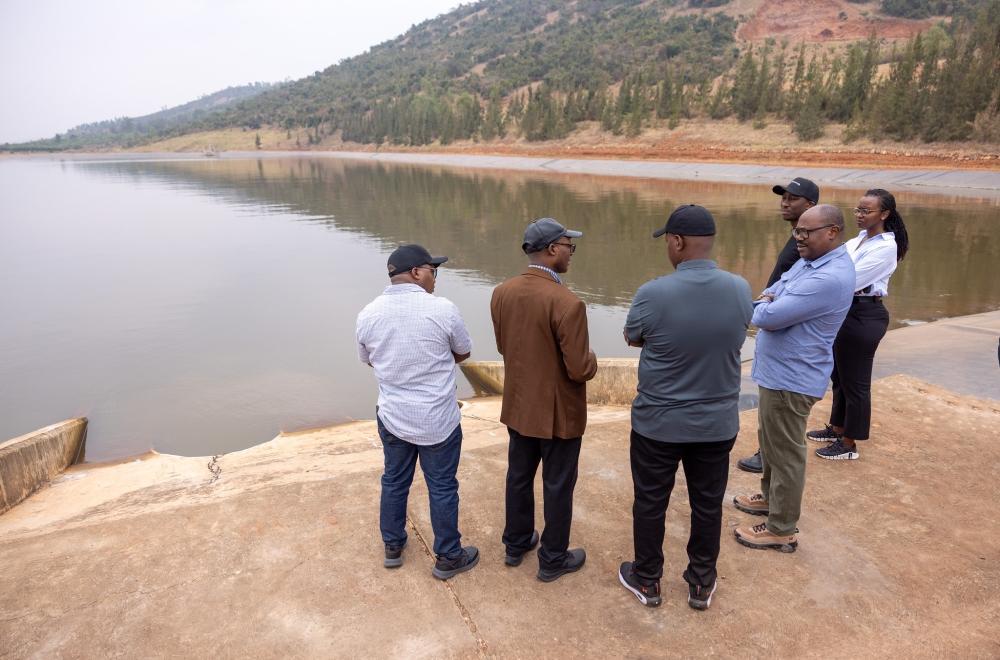Africa-Press – Rwanda. The government plans to expand climate-resilient agriculture through major irrigation projects over the next five years, Prime Minister Justin Nsengiyumva told Parliament on Tuesday, August 12, as he presented the government’s new development programme.
He said the irrigated land area will increase from 71,585 hectares to over 132,171 hectares by 2029.
Jerome Hitayezu, head of the Department of Land Husbandry, Irrigation Innovation, and Technology Transfer at the Rwanda Agriculture and Animal Resources Development Board (RAB), says more than 60,000 hectares will be covered by ongoing and planned projects to meet the target.
Muvumba multi-purpose dam to irrigate 9,640 ha
The government, in 2023, launched the construction of the Muvumba multi-purpose dam, which will cost €121.5 million.
The dam will store 55 million cubic metres of water for irrigation on 9,640 hectares, domestic water supply, livestock, electricity and flood control.
The irrigation is expected to cover Tabagwe, Gatunda, Karama, Rukomo, Nyagatare, Rwempasha, Musheri and Rwimiyaga sectors. The project will be complete by 2027 if all goes well.
Nyabarongo Multipurpose dam to irrigate 20,000 ha
The anticipated multipurpose dam along River Nyabarongo will irrigate over 20,000 hectares of crops.
The irrigation is part of a project expected to cater for water supply, irrigation, as well as electrical power generation. The project will also mitigate the perpetual flooding downstream of the Nyabarongo river that has proved to be hazardous in recent years.
The $214 million project involves constructing a dam that will measure 59 metres high and 363 metres long, creating a reservoir with a storage capacity of 803,000,000 cubic metres..
The dam will irrigate the land in the valley of Nyabarongo, Akagera, and Akanyaru rivers, as well as upstream of Lakes Cyohoha and Rweru in Bugesera District.
China’s Sinohydro was awarded the engineering, procurement, and construction (EPC) contract for the project.
The project has reached 50 per cent completion, with further progress expected before the end of the year, according to officials from the Energy Development Corporation Limited (EDCL).
Mpanga and Mahama irrigation schemes on 7,000 ha
The two irrigation schemes financed by Exim Bank of India at $120 million could cover about 7,000 hectares in Mahama, Mpanga, and Nyamugali sectors in the district.
Two irrigation schemes in Mahama that are still under construction will also require power from the Rusumo hydropower plant.
The first irrigation scheme in Mahama, which will cover some 1,700 hectares, is 68 per cent complete, while the second one, covering over 2,600 hectares, is 64 per cent complete, according to Robert Rama, an irrigation engineer at Rwanda Agriculture and Animal Resources Development Board (RAB). They could be completed by December 2025.
Mugesera-Rweru irrigation schemes on 6,500 ha
Financed at $100 million by Exim Bank of India, the projects will irrigate 3,500 hectares and 3,000 hectares in Mugesera and Rweru respectively in Eastern Province.
Giseke irrigation project on 3,500 hectares
Giseke Dam and Irrigation Project, financed by Exim Bank of China, is a large-scale agricultural infrastructure initiative planned for Gisagara District in Southern Rwanda.
The project, running from 2024 to 2026, is intended to irrigate approximately a gross area of 3,500 hectares of farmland, boosting agricultural productivity and climate resilience.
The government secured a concessional financing agreement worth around $47 million from China for the project.
Gako irrigation project on 2,377 hectares
The project, which runs from 2017 to 2025, was financed by the Government of Rwanda to irrigate 2,377 hectares.
The Gako irrigation scheme is an integral component of the larger Gako Meat Project, a major cattle farming and beef production initiative situated in Bugesera District, Eastern Province, Rwanda.
The irrigation scheme is designed to support fodder production for cattle—crucial for sustaining beef production during dry seasons and ensuring consistent feed supply.
Approximately 1,050 hectares of the Gako project land are currently under irrigation.
Gabiro Agribusiness Hub targets 15,000 ha
Gabiro Agribusiness Hub project, financed by the Government of Rwanda and running from 2019 to 2026, aims to irrigate 5,600 hectares net area in the initial phase.
Water used to irrigate crops at the hub is pumped from River Akagera through dedicated stations.
It is taken to a water dam or operational reservoir with 120,000 m3 capacity, built at a relatively elevated level and then channelled – by gravity flow – to farms through a concrete open canal and pipe system.
The government has invested $118 million (approximately Rwf170 billion) in developing the initiative, Aloysius Ngarambe, CEO of Gabiro Agribusiness Hub Ltd, the company managing the project, told The New Times.
The first phase of the project is 98 per cent complete. The second phase will expand cultivated land by an additional 10,000 hectares—bringing the total to 15,600 hectares.
This expansion will make the project cover some parts of Nyagatare and Gatsibo, both districts in Rwanda’s Eastern Province.
CDAT project
Rwanda is implementing a $300 million project, financed by the World Bank Group, for irrigation systems on over 17,600 ha, as well as land husbandry development on about 11,000 hectares.
The initiative, dubbed the Commercialisation and De-Risking for Agricultural Transformation Project (CDAT), will increase productivity, promote climate-smart agriculture, and benefit at least 235,000 households.
Launched in 2022, the five-year project is being implemented in 37 sites located in 16 districts: Muhanga, Nyanza, Ruhango, Huye, Gisagara, and Nyaruguru in Southern Province; Kayonza, Bugesera, Gatsibo, Nyagatare, and Kirehe in Eastern Province; Rusizi and Nyamasheke in Western Province; Gicumbi in Northern Province; Gasabo and Kicukiro in the City of Kigali.
SAPMP project
The Sustainable Agricultural Productivity and Market Linkage Project (SAPMP project) was funded by the Republic of South Korea through KOICA (Korean International Cooperation Agency) to cover 1,100 hectares.
The $12 million project has two main components: mainly, the increment of agricultural productivity through development of an irrigation and flood protection system at Nyiramageni Marshland.
The second component includes the improvement of sustainability of project achievements in seven Rural Community Support Project (RCSP) sites through supporting the cooperatives, post-harvest handling, access to finance, and access to markets.
SAIP II project
The project will facilitate access to small-scale irrigation equipment for 800 hectares through matching grants and comprehensive support packages, strengthen market linkages and value addition by building the capacity of farmer organisations and value chain actors, and improve their access to finance.
The project aims to support approximately 175,000 rural households, equating to 700,000 people, with a special focus on female-headed households, youth, and vulnerable groups.
KIIWP-Phase 2 on 2,285 hectares
Kayonza Irrigation and Integrated Watershed Management Project, Phase II (KIIWP-Phase 2), in Eastern Province, Kayonza District, Ndego Sector, aims to rescue drought-affected citizens from hunger.
The second phase cost $59 million to cover 2,285 hectares.
SSIT projects on 15,000 ha
The Small-Scale Irrigation Technology (SSIT) projects are expected to cover 15,358 hectares.
For More News And Analysis About Rwanda Follow Africa-Press






